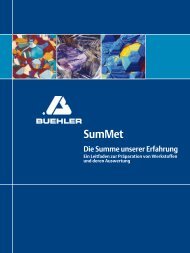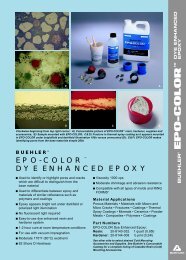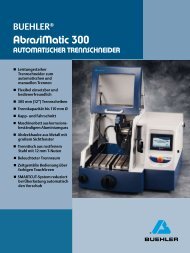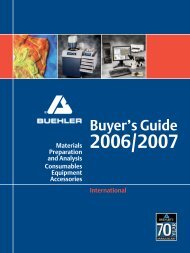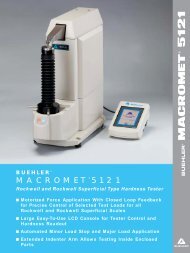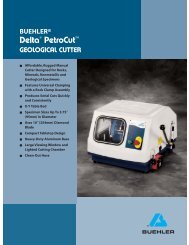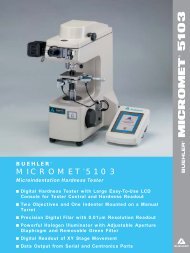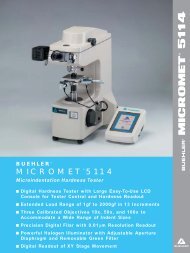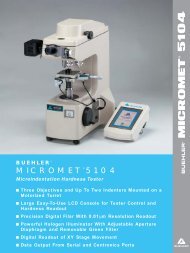You also want an ePaper? Increase the reach of your titles
YUMPU automatically turns print PDFs into web optimized ePapers that Google loves.
3. Compression Mounting<br />
Overview Compression Mounting<br />
Designation Material Properties Application<br />
PhenoCure<br />
black, red, green<br />
Epovit<br />
EpoMet<br />
TransOptic<br />
KonductoMet<br />
ProbeMet<br />
PreMolds<br />
Phenolic mounting compound<br />
with wood flour filler<br />
Thermosetting<br />
Epoxy mounting compound<br />
with filler (glass and mineral<br />
materials) Thermosetting<br />
Epoxy mounting compound<br />
with filler<br />
(mineral)<br />
Thermosetting<br />
fine grained<br />
Thermoplastic<br />
Phenolic mounting compound<br />
Filler: Graphite<br />
Thermosetting<br />
Epoxy mounting compound<br />
Filler: Copper<br />
Thermosetting<br />
Phenolic mounting compound<br />
with wood flour filler<br />
Thermosetting<br />
black/red/green<br />
Small contraction,<br />
Medium hardness<br />
black<br />
Very low contraction<br />
High Hardness<br />
black<br />
No contraction<br />
High Hardness<br />
Transparent<br />
Average hardness<br />
black<br />
Conductive<br />
Copper Colour<br />
Conductive<br />
black<br />
Small contraction<br />
Average hardness<br />
Routine work<br />
Recognition of samples with<br />
colour coded identification<br />
Edge investigations<br />
Embedding hard materials flatness<br />
Edge investigations<br />
Embedding hard materials flatness<br />
Transparent Embedding<br />
Targeted preparation<br />
Embedding sensitive samples<br />
SEM-applications<br />
SEM-applications,<br />
Electrolytic polishing<br />
Routine work<br />
Recognition of samples with<br />
identification colours<br />
Selection Criteria for Compression Moulding<br />
Product Transparency Shore D Edge Retention Shrinkage Cycle Time<br />
PhenoCure B/R/G � 88 � Some, small < 10 min<br />
Epovit � 94 �� Negligible < 10 min<br />
EpoMet � 96 ��� None < 10 min<br />
Diallyl Phthalate � 91 �� Negligible < 10 min<br />
TransOptic ��� 80 � Some, small < 20 min<br />
KonductoMet I � 88 � Some, small < 10 min<br />
ProbeMet � 94 ��� None < 10 min<br />
PreMolds � 88 � Some, small < 10 min<br />
Compression Mounting<br />
��� Very Good �� Good � Average � Not suitable<br />
During compression mounting the sample is<br />
embedded under temperature and pressure. One<br />
advantage of compression mounting is in the very high<br />
hardness of our thermosetting polymers, which is only<br />
achievable with speical cold mounting materials. A<br />
further advantage is the ease of handling. With all hot<br />
compression mounts, cooling the sample under<br />
pressure is recommended, and is essential with<br />
thermoplastics in order to prevent the "cotton ball"<br />
effect. Buehler mounting presses are designed with an<br />
efficient linear cooling cycle. With the hot compression<br />
mounts, we differentiate between thermosetting<br />
polymers and thermoplastics:<br />
Thermosetting polymers are powders, and fuse under<br />
simultaneous pressure and heating. Fillers can improve<br />
hardness and shrinkage. Different powder sizes affect<br />
the flow characteristics. For ease of use and rapid<br />
handling, the PhenoCure phenolic compound is<br />
available in a tablet form called Premoulds. They are<br />
suitable to mount samples not sensitive to pressure.<br />
Premoulds are handy and shorten the embedding<br />
cycle.<br />
Thermoplastics are acrylic mounting materials that<br />
melt when heated, then polymerise when cooled under<br />
pressure, therefore requiring longer cooling times.<br />
Thermoplastics, unlike thermosetting polymers, can be<br />
melted after hardening. Thermoplastic curing is<br />
reversible and the mount can be melted again at any<br />
time. They are very suitable as embedding compounds<br />
for pressure-sensitive samples. Here the acrylic powder<br />
is melted without pressure and then subjected to<br />
pressure when the final temperature is reached and<br />
during cooling.<br />
MOUNTING<br />
17



